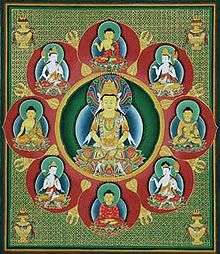Five Dhyani Buddhas


In Vajrayana Buddhism, the Five Dhyani Buddhas (Chinese: 金刚界五智如来 / 五方佛), also known as the Five Wisdom Tathāgatas (Chinese: 五智如来; pinyin: Wǔzhì Rúlái), the Five Great Buddhas and the Five Jinas (Sanskrit for "conqueror" or "victor"), are representations of the five qualities of the Buddha. The term "dhyani-buddha" is first recorded in English by the British Resident in Nepal, Brian Hodgson,[1] in the early 19th century, and is unattested in any surviving traditional primary sources.[2] These five Buddhas are a common subject of Vajrayana mandalas. These five Buddhas are the primary object of realization and meditation in Shingon Buddhism, a school of Vajarayana Buddhism founded in Japan by Kūkai.
Origination
The Five Wisdom Buddhas are a later development, based on the East Asian Yogācāra elaboration of concepts concerning the jñāna of the Buddhas, of the trikaya or "three body" theory of Buddhahood. Dhyani Buddhas are aspects of the dharmakaya "dharma-body", which embodies the principle of enlightenment in Buddhism.
Initially, two Buddhas appeared to represent wisdom and compassion: Akshobhya and Amitābha. A further distinction embodied the aspects of power, or activity, and the aspect of beauty, or spiritual riches. In the Golden Light Sutra, an early Mahayana text, the figures are named Dundubishvara and Ratnaketu, but over time their names changed to become Amoghasiddhi, and Ratnasambhava. The central figure came to be called Vairocana.
When these Buddhas are represented in mandalas, they may not always have the same colour or be related to the same directions. In particular, Akshobhya and Vairocana may be switched. When represented in a Vairocana mandala, the Buddhas are arranged like this:
| Amoghasiddhi (north) | ||
| Amitabha (west) | Vairocana (principal deity/meditator) | Akshobhya (east) |
| Ratnasambhava (south) |
Qualities
There is an expansive number of associations with each element of the mandala, so that the mandala becomes a cipher and mnemonic visual thinking instrument and concept map; a vehicle for understanding and decoding the whole of the Dharma. Some of the associations include:
| Family/Buddha | Colour ← Element → Symbolism | Cardinality → Wisdom → Attachments → Gestures | Means → Maladaptation to Stress | Season | Wisdom |
|---|---|---|---|---|---|
| Buddha/Vairocana | white ← space → wheel | center → all accommodating → rūpa → Teaching the Dharma | Turning the Wheel of Dharma → ignorance | n/a | 法界体性智, Hokkai taishō chi: The wisdom of the essence of the dharma-realm meditation mudra.[3] |
| Karma/Amoghasiddhi | green ← air, wind → double vajra | north → all accomplishing → mental formation, concept → fearlessness | protect, destroy → envy, jealousy | autumn | 成所作智, Jōshosa chi: The wisdom of perfect practice. |
| Padma/Amitābha | red ← fire → lotus | west → inquisitive → perception → meditation | magnetize, subjugate → selfishness | summer | 妙観察智, Myōkanza chi: The wisdom of observation. |
| Ratna/Ratnasambhava | gold/yellow ← earth → jewel | south → equanimous → feeling → giving | enrich, increase → pride, greed | spring | 平等性智, Byōdōshō chi: The wisdom of equanimity. |
| Vajra/Akshobhya | blue ← water → sceptre, vajra | east → nondualist → vijñāna → humility | pacify → aggression | winter | 大円鏡智, Daienkyō chi: The wisdom of reflection. |
The five Tathāgathas are protected by five Wisdom Kings, and in Japan are frequently depicted together in the Mandala of the Two Realms and are in the Shurangama Mantra revealed in the Śūraṅgama Sūtra. They each are often depicted with consorts, and preside over their own pure lands. In East Asia, the aspiration to be reborn in a pure land is the central point of Pure Land Buddhism. Although all five Buddhas have pure lands, it appears that only Sukhavati of Amitābha, and to a much lesser extent Abhirati of Akshobhya (where great masters like Vimalakirti and Milarepa are said to dwell) attracted aspirants.
| Buddha (Skt) | Consort | Dhyani Bodhisattva | Pure land | Bīja |
|---|---|---|---|---|
| Vairocana | White Tara or Dharmadhatvishvari | Samantabhadra | central pure land Akanistha Ghanavyuha | Om |
| Akshobhya | Locanā | Vajrapani | eastern pure land Abhirati | Hum |
| Amitābha | Pandara [4] | Avalokiteśvara | western pure land Sukhavati | Hrih |
| Ratnasaṃbhava | Mamaki [5] | Ratnapani | southern pure land Shrimat | Tram |
| Amoghasiddhi | Green Tara[6][7] | Viśvapāni | northern pure land Prakuta | Ah |
See also
References
- ↑ Bogle (1999) pp. xxxiv-xxxv
- ↑ Saunders, E Dale, "A Note on Śakti and Dhyānibuddha," History of Religions 1 (1962): pp. 300-06.
- ↑ Japanese Architecture and Art Net Users System. (2004). JAANUS / hokkai jouin 法界定印. Available: http://www.aisf.or.jp/~jaanus/deta/h/hokkaijouin.htm. Last accessed 27 Nov 2013.
- ↑ "Pandara The Shakti of Amitabha". Buddhanature.com. Retrieved 2013-06-14.
- ↑ "Mamaki The Shakti of Aksobhya". Buddhanature.com. Retrieved 2013-06-14.
- ↑ "chart of the Five Buddhas and their associations". Religionfacts.com. 2012-12-21. Retrieved 2013-06-14.
- ↑ Symbolism of the five Dhyani Buddhas Archived March 8, 2009, at the Wayback Machine.
Bibliography
- Bogle, George; Markham, Clements Robert; and Manning, Thomas (1999) Narratives of the Mission of George Bogle to Tibet and of the Journey of Thomas Manning to Lhasa ISBN 81-206-1366-X
- Bucknell, Roderick & Stuart-Fox, Martin (1986). The Twilight Language: Explorations in Buddhist Meditation and Symbolism. Curzon Press: London. ISBN 0-312-82540-4
External links
| Wikimedia Commons has media related to Dhyāni Buddha. |
- Five Dhyani Buddhas - chart of the Five Buddhas and their associations.
- StudyBuddhism.com - The Five Buddha-Families and Five Dhyani Buddhas
- Five Dhyani Buddhas - Painting of the Five Buddhas at Padmaloka.
- Symbolism of the five Dhyani Buddhas
- Color Symbolism In Buddhist Art
- Mark Schumacher: Godai Nyorai (Japanese) - Five Buddha of Wisdom Five Buddha of Meditation Five Jina | Five Tathagatas
- The Five Buddha Families - From Journey Without Goal: The Tantric Wisdom of the Buddha by Chögyam Trungpa, Shambhala.org (archived 2007)